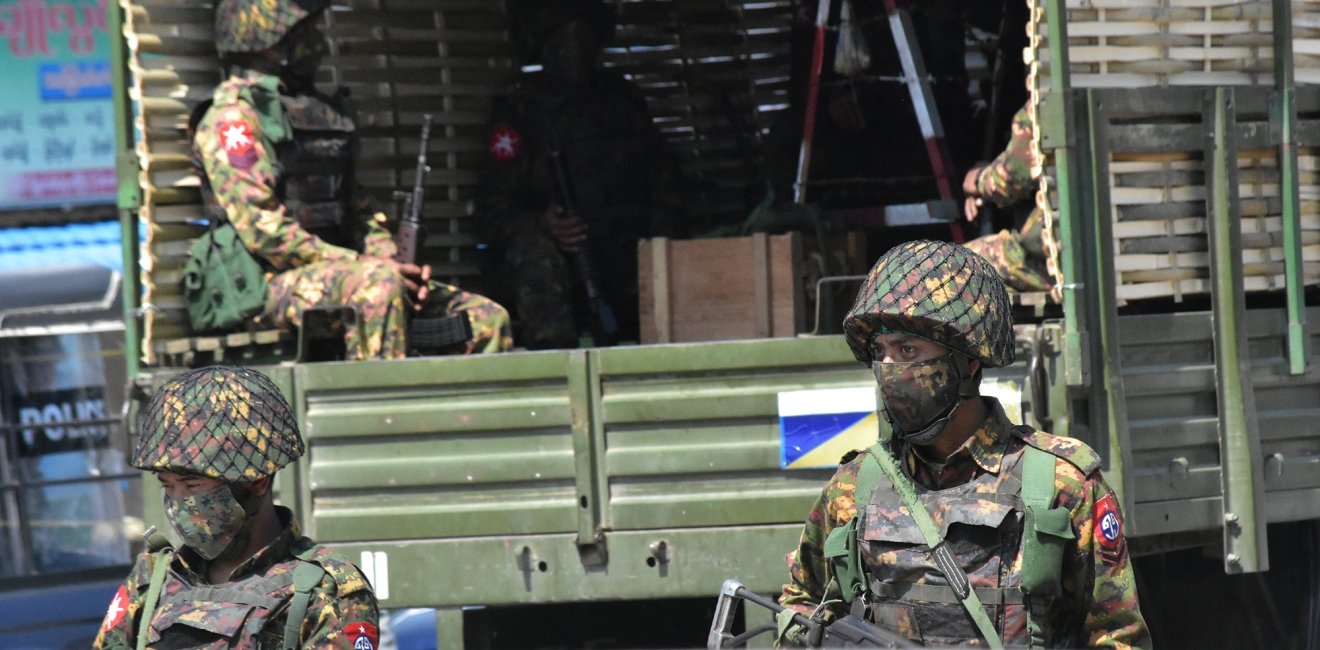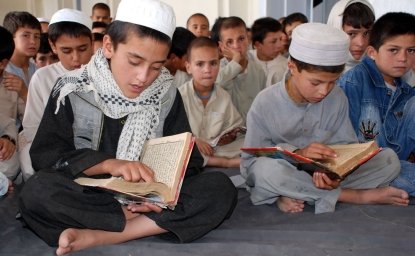
A blog of the Indo-Pacific Program
With a high-intensity civil war looming, Myanmar’s future hangs in the balance. Whereas Myanmar’s military (the Tatmadaw) looked capable of crushing resistance in the first few days of the coup, their inability to tamp down on the protests and other signs of struggle, such as reports of heavy losses and some defections, render the prospects for the military’s consolidation of power much murkier. In May 2021, the National Unity Government (NUG)—a group of ousted National League for Democracy (NLD) politicians, activists, and representatives from several ethnic minority groups—announced the creation of a “People’s Defense Force” to oppose the military regime. The question now emerges: can the National Unity Government organize an effective fighting force and defeat the Tatmadaw on the battlefield? Several military challenges—most importantly the lack of a unified pan-ethnic “Federal Army” and an inability to contest control of the air—mean that the NUG will find it difficult to achieve victory beyond the rugged terrain that dominates the country’s borderlands.
High-Intensity Civil War
Although the protests and Civil Disobedience Movement (CDM) launched in response to the Tatmadaw’s February 1st coup began as non-violent resistance, the military’s indiscriminate crackdown created the conditions for outright, high-intensity civil war. As some have indeed argued, Myanmar is not in an identical situation to Syria, and the country has long suffered from various Ethnic Armed Organization (EAO)-led insurgencies in its outlying border states—with some even dating back to independence. However, the coup by contrast sows the seeds for a higher-intensity civil war reaching into the previously seldom-impacted, Bamar-dominated central regions.
The anti-junta movement’s determination and the Tatmadaw’s unwillingness to restrain itself has now resulted in a growing sentiment that military conflict may be necessary to defeat the coup. The NUG rejects negotiations with the Tatmadaw until political prisoners are released and openly calls for the removal of the military from political life. On the junta’s part, the elimination of a provision for the release of detainees in ASEAN’s 5-point consensus—as well as the junta’s apparent disregard for international pressure—indicate that the two sides’ demands are intractable enough for war to be likely. With little trust in the ASEAN- and China-led negotiation process and grim prospects in the case of surrender, the NUG has few alternatives to armed resistance.
The National Unity Government’s Military Challenges
The NUG has decided to engage in military struggle and organize armed resistance to the junta. As a precursor to a promised “Federal Army” uniting the disparate EAOs under a single command, the NUG announced the development of a “People’s Defense Force.” Although details are scarce as to its organizational structure or design, this move constitutes the first steps in the NUG’s decision to engage in direct military conflict with the Tatmadaw. In recent months, some local militias operating under the banner of “People’s Defense Forces” have indeed engaged the Tatmadaw and reportedly inflicted casualties. Whether these groups are within a loose NUG-directed structure, or—more likely—locally organized units operating independently, remains to be seen.
Some hope remains for the NUG’s new army to organize itself. Two EAOs, the Kachin Independence Army (KIA) and about half of the combat brigades making up the Karen National Union (KNU), continue to launch attacks and inflict significant casualties against the Tatmadaw in support of the resistance, including the downing of a helicopter. Other local militia groups, such as the Chinland Defense Force, are organizing separately, while a spate of bombings throughout Myanmar’s cities against Tatmadaw targets are ongoing. Political assassinations of regime personnel also appear to be ramping up, a key element of insurgency and political warfare. Other reports indicate that defections from the military and police are occurring (although not yet at a scale likely to tip the tide). Meanwhile, numerous anti-junta demonstrators have reportedly fled to EAO-held areas to receive training and shelter.
Unfortunately for the NUG, challenges also remain significant. Historically, thousands fled to rural regions after the military’s crackdown on the 1988 pro-democracy uprising to continue the fight against the Tatmadaw but ultimately failed in their campaign. Today, several obstacles stand in the NUG’s path. For one, urban guerilla warfare—increasingly the tactic of choice for hyperlocal resistance groups, as in Mandalay—has a poor record of success in history. Furthermore, civilians have reportedly made use of homemade weapons and bombs, but equipping a sizeable army seems unlikely. The EAOs may produce arms locally or acquire them from black market dealers in China or Thailand, but procuring enough to field an army capable of taking territory in the country’s center will be difficult. Despite being stretched thin, the Tatmadaw is still a well-equipped and large force commanding some 300,000 to 350,000 troops, relatively modern foreign military equipment, and a range of allied small militias and Border Guard Forces. All of the anti-junta EAOs united would struggle to overcome such a force, as combined they number only one-fifth of the Tatmadaw’s strength. Finally, as demonstrated in the Tatmadaw’s offensive against the locally-organized Chinland Defense Forces in Mindat, militia groups will find it hard to hold territory against the military in a pitched battle as deficits in heavy weaponry, artillery, and airpower inflict a heavy toll.
Of these challenges, two more stand out as the most detrimental to the anti-junta forces: a lack of EAO unity and no airpower. The other challenges may be severe and detrimental but arguably surmountable. However, without uniting most EAOs and countering Tatmadaw airpower, the NUG and its People’s Defense Force will find it very challenging to defeat the junta on the battlefield.
Military Challenge 1: EAO Reluctance
Lacking in military capability and with the existing 20-some EAOs already benefiting from decades of insurgency experience, established supply lines, base areas, and combat-capable units, the NUG quickly promised various reforms to appeal to Myanmar’s EAO insurgent groups and marginalized ethnic minorities, most notably via its announcement of a planned Federal Army.
So far two major EAOs, the KIA and a large portion of the KNU, have entered into sustained, direct military conflict with the Tatmadaw, while some other groups also signaled their opposition to the junta. The Chin National Front, a much smaller group, formally allied itself with the NUG, and the somewhat larger Karenni Army and its political wing, the Karenni National Progressive Party, clashed with the Tatmadaw on the side of the local civilian resistance in Kayah State. That said, the Karenni Army’s leadership remains careful to avoid triggering further direct combat with the junta. Additionally, the 10 signatories of the 2015 Nationwide Ceasefire Agreement are reportedly reaching out to other EAOs to forge an anti-junta coalition. Finally, members of the Northern Alliance (which the KIA is a part of), issued statements opposing the Tatmadaw and some components have even launched limited attacks.
However, as explained by an officer with the KNU, the EAOs remain wary of the NUG due to past difficulties with the NLD and their own sometimes violently divergent interests. For example, the Arakan Army, despite opposing the coup and issuing supportive statements, seems intent on forging its own path and furthering its goal of autonomy apart from the NUG. Others, like the powerful United Wa State Army (UWSA) under China’s unofficial protection, maintain a careful neutrality.
For now, a Federal Army encompassing most of the EAOs beyond the KIA and KNU appears more a goal than reality. Even the KNU and KIA operate in geographically distant regions, with the KIA in Kachin State to the north and KNU along the border with Thailand in the southeast. To make matters more complicated, some KNU leaders have made statements in recent weeks on abiding by the 2015 Nationwide Ceasefire Agreement, which indicates political division within the organization as some factions continue fighting while others hope to deescalate. Elsewhere, the Tatmadaw has been making overtures to peel off other large groups, such as the Arakan Army. The NUG itself seems to realize that pan-ethnic unity is doubtful at this time, as signaled NUG Foreign Minister Zin Mar Aung’s non-committal answer to a question on EAO participation.
Military Challenge 2: Tatmadaw Air Superiority
Secondly, Tatmadaw air superiority will constitute perhaps the steepest obstacle. In retaliation for KIA and KNU offensives, the Tatmadaw utilizes its fleet of Russian-supplied helicopters and multi-role fighters to launch air strikes against civilian targets and enemy troops. Although the KIA and others have demonstrated the capability to shoot down Tatmadaw aircraft—and some groups have access to the effective Chinese-produced FN-6 MANPADs—countering the Tatmadaw’s air power will prove nigh impossible with the opposition’s arsenal. The regime’s MiG-29s, as well as the Russian-built SU-30s scheduled for delivery, remain out of reach, and the junta’s air superiority provides a huge military advantage. Additionally, the junta has been deploying Chinese drones to monitor protests, and these CH-3A unmanned aerial vehicles are capable of carrying munitions.
The role of air power in warfare and its efficacy in counter-insurgency remains debated, but it will be difficult for the NUG to transform itself into a force capable of conventionally challenging the Tatmadaw sans its own air power or effective countermeasures. For an authoritarian government with little concern for “hearts and minds,” the Tatmadaw can deploy its air power at will to defeat concentrated opposition forces. In Syria, Russian and regime air power devastated opposition forces, while NATO’s imposition of a no-fly zone and subsequent aerial campaign in Libya spelled doom for Ghaddafi’s government. Although the Assad regime’s victory in Syria is not complete, the splintering of the opposition and Russian fires laid the groundwork for pro-regime forces to retake lost territory and largely overcome the rebels. It is thus no coincidence that the NUG’s Foreign Minister called for no-fly zones in a New York Times op-ed.
Unfortunately for the NUG, there is little hope for outside military support. Despite some discussion of U.S. or UN military intervention with air power in Myanmar, the odds of American or UN-sponsored action are vanishingly small. Chinese and Russian vetoes on the UN Security Council stymie any firm action, and the U.S. lacks important national interests in Myanmar that would incentivize intervention. Perhaps more importantly, China would almost certainly react extremely negatively to U.S. military presence in its backyard at a time of worsening U.S.-China tensions. In a sign of its desperation, the NUG made public efforts at the cost of some domestic support in the Rakhine to address the NLD’s poor record on the Rohingya crisis after criticism from some U.S. policymakers, but widespread American sympathy will not lead to military action.
China, Myanmar’s most influential neighbor, may dislike the coup’s instability and has met with the NUG’s predecessor, but China prioritizes pragmatism in pursuing its national interests. China prefers a winner, and, if it were to intervene, siding with the NUG would be a poor bet. Beijing increasingly seems to realize that the Tatmadaw will likely emerge victorious, and it stands to make gains for its strategic initiatives by backing the junta. If it comes, Chinese military involvement would most likely aim to defend their strategic China-Myanmar Economic Corridor investments (which are already at risk) on either the junta’s side or as a third-party peacekeeping force intended to secure its own holdings. The prospect of the People’s Liberation Army erecting a no-fly zone benefiting the NUG is infinitesimal.
Limited Prospects for NUG Military Victory
With its military challenges, an NUG victory by force of arms appears remote, and outside help for the opposition is a dim prospect. In all likelihood, the Tatmadaw quells the protests at the cost of the economy and public support to rule a diminished, isolated, and highly coercive central government under a veneer of managed democracy. In the event of a longer-term junta victory, the surviving opposition would likely transform into yet another insurgency along Myanmar’s borderlands (as it did after the 1988 uprising), while the EAOs would likely continue to struggle for autonomy or accommodate themselves with the military depending on the group. Myanmar in this scenario would likely resemble a failed state.
Certainly, other outcomes beyond a Tatmadaw “victory” remain possible but unlikely given the NUG’s prevailing military challenges. The Tatmadaw with all its air power has not yet overcome the myriad EAOs operating along the hilly and heavily-forested border states, and the anti-junta opposition’s commitment is clear. A regime collapse triggered by sustained political and economic pressure by the protesters and CDM could still occur if the crisis drags out long enough, while a brokered settlement or ceasefire remains in the realm of possibility despite ASEAN’s division. However, the Tatmadaw looks to have the upper hand, and the prospects of opposition military victory against the Tatmadaw are slim under current circumstances.
Follow the Asia Program on Twitter @AsiaProgram. or join us on Facebook.
The views expressed are the author's alone, and do not represent the views of the U.S. Government or the Wilson Center. Copyright 2020, Asia Program. All rights reserved.
Author


Indo-Pacific Program
The Indo-Pacific Program promotes policy debate and intellectual discussions on US interests in the Asia-Pacific as well as political, economic, security, and social issues relating to the world’s most populous and economically dynamic region. Read more





